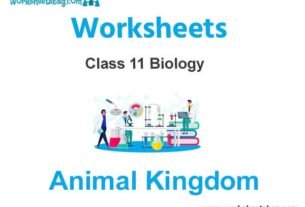Students should refer to Worksheets Class 11 Biology Cell The Unit of Life Chapter 8 provided below with important questions and answers. These important questions with solutions for Chapter 8 Cell The Unit of Life have been prepared by expert teachers for Class 11 Biology based on the expected pattern of questions in the Class 11 exams. We have provided Worksheets for Class 11 Biology for all chapters on our website. You should carefully learn all the important examinations questions provided below as they will help you to get better marks in your class tests and exams.
Cell The Unit of Life Class 11 Biology Worksheet
Question. One of the most important functions of the plasma membrane is :-
(a) Formation of nuclear membrane
(b) Transport of molecules across it
(c) Exocytosis
(d) Detoxification
Answer
B
Question. Which of the following is not a function of cell wall ?
(a) Protection from mechanical damage and infection
(b) Cell to cell interaction
(c) Barrier to undesirable macromolecules
(d) Secretion
Answer
D
Question. Space between parallel nuclear membranes is called perinuclear space which is :-
(a) 1050 nm
(b) 0.1 0.4 mm
(c) 10 50 Å
(d) 1 4 nm
Answer
A
Question. Regarding to inclusion bodies – find out the incorrect statement
(a) It is site of food storage
(b) It is single membrane bounded
(c) They lie freely in cytoplasm
(d) May found in prokaryotic and eukaryotic cells
Answer
B
Question. Which of the following component is not a constituent of algal cell wall ?
(a) Cellulose
(b) Galactans
(c) Mannans
(d) Hemicellulose
Answer
D
Question. Classification of chromosomes with respect to shape based on –
(a) Structure
(b) Number of telomere
(c) Position of centromere
(d) Position of kinetochore
Answer
C
Question. In plant cells how much volume of cell can be occupied by vacuole ?
(a) 10%
(b) 50%
(c) 90%
(d) 80%
Answer
C
Question. Which of the following constituent is right for endomembrane system ?
(a) ER, Golgi complex, lysosome & nucleus
(b) ER, Golgi complex, lysosome & vacuole
(c) ER, Golgi complex, lysosome & microbodies
(d) ER, Golgi complex, plastids & vacuole
Answer
B
Question. Radial spokes of flagella helps in connection between-
(a) Peripheral doublets
(b) Central singlet microtubules
(c) One of the peripheral doublet and central sheath
(d) Two successive peripheral doublets
Answer
C
Question. Plasma membrane covering of flagella and cilia surrounds the central core, that is known as –
(a) Shaft
(b) Axonema
(c) Radial spoke
(d) Arms
Answer
B
Question. Match the following –
| (A) Robert Brown | (I) Ribonucleoproteins |
| (B) Flemming | (II) Nucleus as cell organelle |
| (C) Palade | (III) Packaging of materials |
| (D) Camillo Golgi | (IV) Staining of nucleus material |
(a) A – (II) B – (IV) C – (I) D – (III)
(b) A – (II) B – (IV) C – (III) D – (I)
(c) A – (I) B – (II) C – (III) D – (IV)
(d) A – (IV) B – (III) C – (II) D – (I)
Answer
A
Question. Fluidity of plasma membrane is due to –
(a) Lipids
(b) Proteins
(c) Carbohydrates
(d) Cholesterol
Answer
A
Question. ……..can not pass through the lipid bilayer, they require a carrier protein of the membrane to facilitate their transport across the membrane
(a) Nonpolar molecules
(b) Polar molecules
(c) Hydrophobic molecules
(d) Both (b) and (c)
Answer
B
Question. Classification of plastids into chloroplast, chromoplast and leucoplast is based on –
(a) Stored food
(b) Pigments
(c) Structure
(d) Size
Answer
B
Question. Which of the following reasons explains best, the close association of Golgi complex with ER ?
(a) Its enzymes works close to ER
(b) It receives material from ER for packaging
(c) It becomes active close to ER
(d) All of the above
Answer
B
Question. An elaborate network of filamentous proteinaceous structures present in the cytoplasm which helps in the maintenance of cell shape is called :-
(a) Endoplasmic reticulum
(b) Plasmalemma
(c) Ribosomes
(d) Cytoskeleton
Answer
D
Question. A Golgi complex has :-
(a) Fixed number of cisternae
(b) Varied number of cisternae
(c) One cisterna in higher plants
(d) Convex trans face and concave cis face cisternae
Answer
B
Question. Nucleus as a “cell organelle” was first described by…..as early as……..
(a) Robert Hooke, 1665
(b) Robert Brown, 1831
(c) Flemming, 1931
(d) Strasburger, 1831
Answer
B
Question. ………….was a German scientist, who observed that all plant tissues are made up of cells. At the same time……….., British scientist studied different type of animal cells.
(a) Rudolf Virchow and Nageli respectively
(b) Mathias Schleiden and Theodore Schwann respectively
(c) Theodore Schwann and Mathias Schleiden respectively
(d) Robert Hooke and Schleiden respectively
Answer
B
Question. The physio-chemical approach to study and understand living organisms is called –
(a) Physiochemical biology
(b) Reductionist biology
(c) Fundamental biology
(d) Biochemical biology
Answer
B
Question. Regarding to cell membrane find out the odd one –
(a) Fluid mosaic model is widely accepted model
(b) Quasi fluid nature of lipids enables the lateralmovement of proteins
(c) All types of molecules can easily pass throughmembrane
(d) Fluid nature of membrane is also important for cell growth & formation of intercellular junctions
Answer
C
Question. Chromosome with centromere slightly away from center is known as –
(a) Metacentric
(b) Submetacentric
(c) Acrocentric
(d) Telocentric
Answer
B

